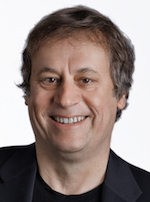Cancer discovery links experimental vaccine and biological treatment
A new study at the University of Wisconsin–Madison has linked two seemingly unrelated cancer treatments that are both now being tested in clinical trials.
One treatment is a vaccine that targets a structure on the outside of cancer cells, while the other is an altered enzyme that breaks apart RNA and causes the cell to commit suicide. The study was published July 13 in the new journal of the American Chemical Society: ACS Central Science.

Ronald Raines
The new understanding could help both approaches, says UW–Madison professor of biochemistry Ronald Raines, who has long studied ribonucleases — enzymes that break apart RNA, a messenger with multiple roles inside the cell. In 1998, he discovered how to alter one ribonuclease to avoid its deactivation in the body. Soon thereafter, he found that the engineered ribonuclease was more toxic to cancer cells than to others.
Raines patented the advance through the Wisconsin Alumni Research Foundation and with UW–Madison chemist Laura Kiessling cofounded Quintessence Biosciences in Madison. They remain shareholders in the firm, which has licensed the patent from WARF and begun early-phase human trials with the ribonuclease at the UW Carbone Cancer Center and MD Anderson Cancer Center in Houston.
The current study began as an effort to figure out why the ribonuclease was selective for cancer cells. To identify which structure on the cell surface helped it enter the cell, Raines screened 264 structures using a specially designed chip. The winner was a carbohydrate called Globo H.
“We were surprised — delighted — to see that because we already knew that Globo H is an antigen that is abundant in many tumors,” Raines says. Antigens are complex molecules with structures that are recognizable to proteins called antibodies. “Globo H is under development as the basis for a vaccine that will teach the immune system to recognize and kill cancer cells,” he says.
Working with Samuel Danishefsky, who solved the difficult problem of synthesizing Globo H at the Memorial Sloan-Kettering Cancer Center in New York, Raines found that reducing the Globo H display on the surface made breast cancer cells less vulnerable to ribonucleases like those that Quintessence is testing. “This was exciting, as we now have a much clearer idea of how our drug candidate is working.”
Biochemistry Professor John Markley aided the research with studies of the structure of the molecules in question.
The picture that emerges from the work is of ribonucleases patrolling our bodies, looking for telltales of cancer cells, Raines says. “We are working to demonstrate this surveillance more clearly in mice, but don’t have direct evidence yet.”
As other scientists test whether using a vaccine will start an immune attack on Globo H, Raines says, “we are probing a different type of immunity. This innate immunity does not involve the immune system. It’s a way for our bodies to fight cancer without using white blood cells or antibodies, just an enzyme and a carbohydrate.”




